Papers by Fernando Casadevall
IEEE International Symposium on Personal, Indoor and Mobile Radio Communications, 2002
The general packet radio service (GPRS) system provides a packet switched data service with quali... more The general packet radio service (GPRS) system provides a packet switched data service with quality of service (QoS) over a GSM infrastructure. In order to cope with the QoS requirements, packet scheduling strategies are used. On the other hand, GPRS introduces four coding schemes with different degrees of data protection according to the radio channel conditions. The selection of an
One of the most challenging issues in the area of mobile communication is the deployment of IP- b... more One of the most challenging issues in the area of mobile communication is the deployment of IP- based wireless multimedia networks in public and business environments. The public branch may involve public mobile networks, like UMTS as 3G system, while the business branch introduces local radio access networks by means of W-LANs. Conventional mobile networks realise mobile specific functionality, e.g.
2005 IEEE 16th International Symposium on Personal, Indoor and Mobile Radio Communications, 2005
Common Radio Resource Management strategies are devoted to achieve an efficient usage of the pool... more Common Radio Resource Management strategies are devoted to achieve an efficient usage of the pool of radio resources available in a heterogeneous radio access network context. This paper describes the functionalities associated with the common vision of radio access technologies, the different possibilities in the functional model split and the corresponding implementation considerations. Index terms -Common Radio Resource Management, UTRAN, GERAN, WLAN, Beyond 3G systems.
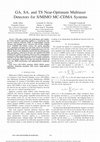
2008 Fourth International Conference on Wireless Communication and Sensor Networks, 2008
This paper analyzes the performance and complexity of four heuristic approaches applied to a sync... more This paper analyzes the performance and complexity of four heuristic approaches applied to a synchronous multicarrier multiuser detection (MuD) of single/multiple transmit antennas and multiple receive antennas code division multiple access (S/MIMO MC-CDMA) system. The genetic algorithm (GA), simulation annealing (SA) and Tabu search (TS) heuristic algorithms (HA) in a single-objective optimization form were considered. Monte-Carlo simulations showed that the performances, after convergence, achieved by the four near-optimum HA-MuD S/MIMO MC-CDMA are identical. However, their computational complexities differ depending on the operation system conditions. Therefore, the HA-MuD complexities were carefully analyzed in order to determine which one has the best trade-off between bit error rate (BER) performance and implementation complexity aspects.
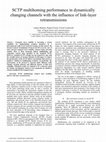
IEEE Vehicular Technology Conference, 2006
Transport layer mobility is becoming a serious candidate for implementing seamless handover in a ... more Transport layer mobility is becoming a serious candidate for implementing seamless handover in a heterogeneous radio access network scenario. In this context, the Stream Control Transmission Protocol (SCTP) is in the core of most relevant transport layer mobility schemes being currently studied. Most of these proposals inherit multihoming and congestion control rules specified in the standard SCTP. However, standard SCTP's design was not targeted to cope with the variable nature of wireless channels. In this paper we analyse the performance of the SCTP failover mechanism when used as a handover solution in multihoming scenarios. In particular, the performance of the protocol is assessed under different radio channel variation patterns and different degrees of link level reliability. Obtained results are claimed to be a reference point for further investigation related to new proposals for handover schemes handled at the transport layer.
IEEE International Symposium on Personal, Indoor and Mobile Radio Communications, PIMRC, 2010
Spectrum occupancy modeling in the context of Dynamic Spectrum Access/Cognitive Radio (DSA/CR) co... more Spectrum occupancy modeling in the context of Dynamic Spectrum Access/Cognitive Radio (DSA/CR) constitutes a rather unexplored research area that still requires much more effort. This paper addresses the problem of modeling spectrum occupancy in the spatial domain by proposing a novel theoretical approach that enables modeling the occupancy level perceived at any geographical location based on the knowledge of some simple primary signal parameters. The validity of the theoretical model is verified with extensive empirical measurement results. Some examples of its potential applicability are discussed as well.
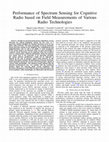
2010 European Wireless Conference, EW 2010, 2010
Despite its practical performance limitations, energy detection has gained popularity during the ... more Despite its practical performance limitations, energy detection has gained popularity during the last years as a spectrum sensing technique for dynamic spectrum access in cognitive radio networks. The main advantages of energy detectionbased spectrum sensing are its simplicity, low computational and implementation costs as well as its ability to work irrespective of the actual signal to be detected. Since no prior knowledge is required, energy detection can be employed when the secondary receiver cannot gather sufficient information about the primary user signal. Due to the generality of its operating principle, the energy detector performance would not be expected to depend on the type of primary signal being detected. In this context, this paper evaluates the performance of energy detectionbased spectrum sensing for several real-world primary signals of various radio technologies. The obtained results indicate that the detection performances may vary notably with the considered primary signal but converge under certain conditions. The practical consequences of the different observed performances for several primary radio technologies are illustrated and discussed.
ACM International Conference Proceeding Series, 2011
The development of the Dynamic Spectrum Access/Cognitive Radio (DSA/CR) technology can significan... more The development of the Dynamic Spectrum Access/Cognitive Radio (DSA/CR) technology can significantly benefit from the availability of realistic models able to accurately capture and reproduce the statistical properties of spectrum usage in real wireless communication systems. Relying on field measurements of real systems, this paper analyzes the joint time-frequency statistical properties of spectrum usage and develops adequate models describing the observed characteristics. Based on such models, a sophisticated method is also proposed to generate artificial spectrum data for simulation or other purposes. The proposed method is able to accurately reproduce the statistical time-frequency characteristics of spectrum usage in real systems.
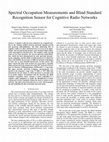
2009 4th International Conference on Cognitive Radio Oriented Wireless Networks and Communications, 2009
Cognitive radio has been claimed to be a hopeful solution to the existing conflicts between spect... more Cognitive radio has been claimed to be a hopeful solution to the existing conflicts between spectrum demand growth and spectrum underutilization. The basic underlying idea of cognitive radio is to allow unlicensed users to access in an opportunistic and non-interfering manner some licensed bands temporarily unoccupied by licensed users. The cognitive radio concept relies on two basic premises: the current spectrum underutilization, which has been demonstrated in some spectrum measurements campaigns, and the ability of unlicensed users to effectively detect and identify the presence of different licensed technologies in order not to cause harmful interference. In this context, this paper reports the joint work on these two areas that is currently being carried out in the framework of the FP7 Network of Excellence in Wireless COMmunications (NEWCOM++). Concretely, this paper presents spectrum occupancy measurements conducted in the frequency range from 75 MHz to 7075 MHz that demonstrate the low degree to which spectrum is currently used in an urban outdoor environment and also describes the blind standard recognition sensor concept, a sensor embedded in a cognitive radio equipment to enable the identification of many commercial wireless standards without the need to connect to any network. The joint research in both areas is a key step in promoting and validating the idea of dynamic spectrum usage.
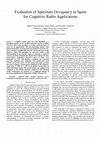
VTC Spring 2009 - IEEE 69th Vehicular Technology Conference, 2009
Cognitive Radio (CR) has been identified as a promising solution to the so-called spectrum scarci... more Cognitive Radio (CR) has been identified as a promising solution to the so-called spectrum scarcity problem. The basic idea of this paradigm is to allow unlicensed users to access in an opportunistic and non-interfering manner some licensed bands that are temporarily unoccupied by licensed users. CR is expected to significantly increase current spectrum usage. However, before this paradigm can turn into reality, a full understanding of the dynamic usage of spectrum is required. Current spectrum utilization has already been evaluated in some measurement campaigns. However, most of them were performed in USA and therefore evaluated the American spectrum regulation and utilization. Few studies have been carried out in other places. In this context, this paper presents spectrum occupancy measurements conducted in the frequency range from 75 MHz to 3 GHz in an outdoor environment in urban Barcelona, Spain. The measurements are analyzed and compared to the official spectrum regulations. The obtained results demonstrate the existence of a significant amount of spectrum available for the deployment of future CR networks.
2008 IEEE 10th International Symposium on Spread Spectrum Techniques and Applications, 2008
This paper analyzes the performance of two heuristic approaches applied to a synchronous multicar... more This paper analyzes the performance of two heuristic approaches applied to a synchronous multicarrier multiuser detection (MUD) of multiple receive antennas code division multiple access (SIMO MC-CDMA) system. The particle swarm optimization (PSO) with weighting particle position based on combining multi-fitness functions (woPSO) is proposed and compared with the conventional PSO SIMO MC-CDMA. The woPSO strategy deal with the multi-objective dilemma imposed by the spatial diversity that results in independent likelihood function for each receive antenna. Additionally, the computational complexity of these algorithms was taken into account in order to show which one has the best trade-off in terms of performance and implementation complexity aspects.
2006 IEEE 63rd Vehicular Technology Conference, 2006
This paper addresses the analysis of WCDMA systems with repeaters deployment. The real different ... more This paper addresses the analysis of WCDMA systems with repeaters deployment. The real different path delays, taking into account the repeaters presence and the finite nature of the time window of Rake receivers are considered. This allows an enhanced analysis with respect to classical approaches from a system level viewpoint. Results show that not taking into account these effects imply erroneous metrics. Indeed, some of the most relevant parameters in network performance evaluation are clearly affected.
40th IEEE Conference on Vehicular Technology, 1990
The effects of RF signal processing impairments in a LINC transmitter are analyzed. A theoretical... more The effects of RF signal processing impairments in a LINC transmitter are analyzed. A theoretical analysis of the effect of three different kinds of imbalances between the parallel signal paths in a real LINC transmitter is presented. These include the power gain and delay (or phase) imbalance between the two RF paths and the different nonlinear characteristics of both RF
2009 First International Conference on Advances in Satellite and Space Communications, 2009
Since the maximum likelihood (ML) decoding results too complex when the modulation order and the ... more Since the maximum likelihood (ML) decoding results too complex when the modulation order and the number of receive antennas increase, an efficient reduced complexity
This paper presents an analysis of soft-output equalization and coding techniques applied to 4 an... more This paper presents an analysis of soft-output equalization and coding techniques applied to 4 and 16-QAM TDMA radio systems for frequency selective fading channels. In particular, typical urban and hilly terrain environments have been considered. The use of the soft information provided by the equalizer enhances the system performance considerably. Specifically, an improvement of more than 4 dB can be achieved in relation to hard decoding techniques. The necessity of introducing some interleaving in order to destroy the channel memory has also been stated. The actual investigated equalizers have been a soft-output decision-feedback equalizer (SODFE) and a soft-decision M-algorithm (SDMA) jointly with convolutional coding and both ideal and finite interleaving
This paper presents a packet transmission scheme that deals with the problems of a TDD CDMA scena... more This paper presents a packet transmission scheme that deals with the problems of a TDD CDMA scenario with different levels of frame structure asymmetry in adjacent base stations by distributing the users in the slots depending on their Time Advance. A multiple access protocol and a scheduling algorithm are also proposed to provide a certain degree of Quality of Service.
Optical and Quantum Electronics, 1984
For data rates above 100 Mbits s -1 multimode optical fibre systems are generally modal dispersio... more For data rates above 100 Mbits s -1 multimode optical fibre systems are generally modal dispersion rather than loss limited and some form of equalization is highly desirable. In this paper a new strategy for the optimum design of an equalized receiver is introduced with the aim of maximizing the repeater spacing. Linear and nonlinear equalizers are briefly reviewed and their relative merits discussed. In the receiver design, Poisson signal statistics and additive Gaussian noise are considered. A new upper bound on the bit error rate which allows an adequate accuracy is proposed. Results obtained for 140 and 560 Mbits s -1 show a noticeable increase of the repeater spacing when the proposed design strategy is introduced.
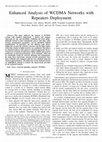
IEEE Transactions on Wireless Communications, 2000
This paper addresses the analysis of WCDMA systems with repeaters deployment. A generic and compa... more This paper addresses the analysis of WCDMA systems with repeaters deployment. A generic and compact expression for up-and downlinks evaluation has been mathematically derived so that transmission powers and other radio resource management parameters can be calculated without simplifications. In particular, the real different path delays, taking into account the repeaters presence and the finite nature of the time window of Rake receivers are considered. This allows an enhanced analysis with respect to classical approaches from a system level viewpoint. Furthermore, higher reliable and accurate predictions on network performance can be obtained, which can be remarkably useful for network planning and management. By using these expressions, relevant network parameters have been evaluated and compared with the ones obtained using the classical approximations. The differences in the obtained metrics are highlighted, putting in evidence the improvement provided by the proposed analysis.
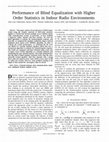
IEEE Transactions on Vehicular Technology, 1997
This paper analyzes the performance of blind equalization using the complex cepstrum of third-ord... more This paper analyzes the performance of blind equalization using the complex cepstrum of third-order moments applied to 4-QAM time division multiple access (TDMA) indoor radio communication systems. In particular, we have modeled a dispersive indoor channel with Rice statistics. We used the blind algorithms to estimate the channel-impulse response, and from this, we computed the equalizer coefficients using a classical minimum mean square error (MMSE) algorithm. In order to evaluate the system performance, we calculated the bit error rate (BER) of a decision feedback equalizer (DFE) that uses a tricepstrum algorithm to estimate the channel-impulse response. The results are compared with those obtained using a least sum of square errors (LSSE) algorithm as a channel estimator and considering the exact channel response. The results obtained show that this kind of blind equalizer performs better than the more classically trained equalizer when Rice channels with a strong direct path and signal-to-noise ratios (SNR's) lower than 20 dB are taken into account. However, some problems relating to the length of time needed for convergence must be solved.
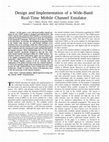
IEEE Transactions on Vehicular Technology, 2000
In this paper, a new wide-band mobile channel emulator for the CODIT project is designed and impl... more In this paper, a new wide-band mobile channel emulator for the CODIT project is designed and implemented. The UMTS code-division testbed (CODIT R2020) is a research project within the European RACE-II program set up by the Commission of the European Community. Our goal is to be able to simulate in the laboratory, in real time, the multipath propagation found in the mobile radio channel. As code-division multiple access (CDMA) is the access technique within the CODIT project, it was realized that the channel emulator must have simultaneously good delay resolution between propagation paths and long duration of the impulse response. These considerations led to a very flexible channel emulator specifically designed to host the new wideband channel models developed within the CODIT project. Our emulator features three independent inputs and two outputs, up to 20 complex propagation paths, 10-MHz radio frequency (RF) bandwidth, a delay resolution of 50 ns, and a maximum duration of the channel impulse response of 80 s. Starting with an explanation of the global structure of the new channel emulator, we derive the optimum design of the interpolation procedures and present the main implementation issues arising from our initial architecture. Finally, we report the results of the laboratory tests of the first prototype of the channel emulator.

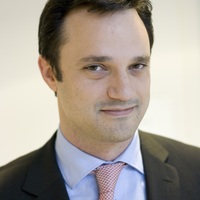




Uploads
Papers by Fernando Casadevall